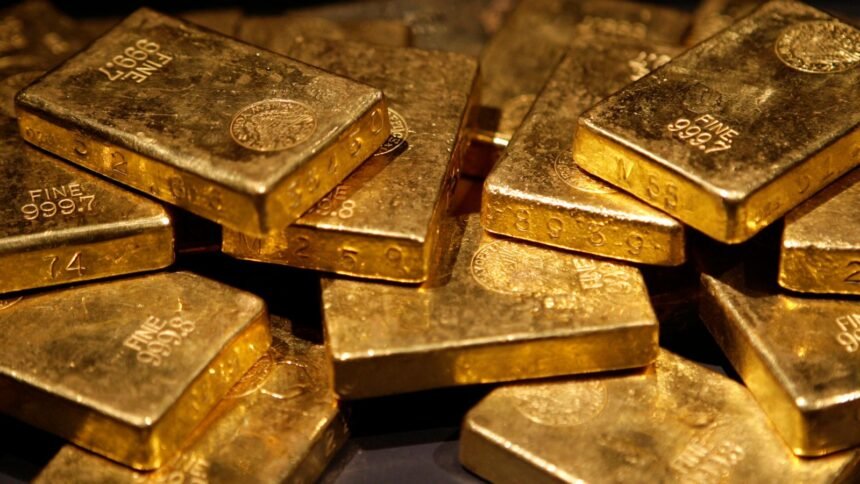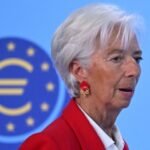A report by the European Central Bank (ECB) issued last week pointed to the growing lack of international confidence in the role of the US dollar as the global reserve currency.
According to the ECB, gold accounted for 20 percent of the global reserves held by central banks, outstripping the euro at 16 percent and coming second to the dollar at 46 percent.
“Central banks continued to buy gold at a record pace,” the ECB said. In 2024, for the third year in a row, central banks bought more than 1,000 tonnes of gold. This was a fifth of the total production for 2024 and twice the annual amount in the decade 2010‒2019.
The amount of gold now held by central banks is approaching the levels of 1965, the ECB noted. But that was under very different conditions.
At that time on basis of the Bretton Woods Agreement of 1944, which was one of the foundations of the post-war global financial system after the devastation of the 1930s, the dollar was backed by gold at the rate of $35 per ounce.
In August 1971, US President Nixon unilaterally abrogated the agreement when he went on Sunday night television to announce that the US would no longer honour its commitment to redeem dollars for gold. Sparked by the growing US trade deficit, it was the initial expression of the economic decline of the US from its dominant position at the end of World War II.
The dollar continued as the global currency but on a new basis. It was now a fiat currency which depended on the strength of the US state and its financial system. But that strength has increasingly been called into question by the series of crises which have gripped the US financial system. The most notable was the crisis of 2008, sparked by the escalation of speculation and parasitism in the US economy.
The dollar’s new role gave the US what was characterised as “exorbitant privilege.” Without the restrictions imposed by the need to maintain gold backing, it could increasingly run up debts and deficits in a way not possible for other countries because there would always be an international demand for dollars. And it used the need of other countries for access to dollars to enforce its demands.
Sanctions against Iran, and the threat of sanctions against European companies that tried to buck the US, were a case in point. In March 2022, there was a leap in this process when the US cut Russia off from the SWIFT international payments system and in combination with the European powers froze the assets of the Russian central bank, amounting to around $300 billion.
This decision sent a shock wave through the international monetary system. If the reserves of a central bank could be seized in this way then what was a safe haven—certainly not US dollars.
As the ECB noted in its report: “Gold demand for monetary reserves surged sharply in the wake of Russia’s full-scale invasion of Ukraine in 2022 and has remained high.”
Gold, it said, appeared to be seen as a hedge against actions and the freezing of assets.
“In five of the 10 largest annual increases in the share of gold in foreign reserves since 1999, the countries involved faced sanctions in the same year or the previous year.”
In 2024 the price of gold rose by 30 percent and so far this year has increased by a further 27 percent, at one stage hitting $3,500 per ounce, 100 times its level when Nixon broke the dollar-gold nexus.
Reporting on the ECB analysis, the Financial Times gave some indication of the extent of these concerns.
“A survey among 57 central banks that were holding gold last year also revealed that concerns about sanctions, expected changes in the global monetary system and the desire to become less dependent on the US dollar were drivers in emerging markets and developing countries,” it said.
The ECB data cover last year. Since then, the forces driving the increase in gold holdings have only intensified. A key accelerant was the launching of the Trump administration’s economic war against the world, with China the chief target, with the announcement of massive “reciprocal tariffs” on the so-called “liberation day” of April 2.
The result was a spike in the yields (interest rates) on long-term US debt, as the price of bonds fell—the two have an inverse relationship. This reflected an expectation in markets of growing financial turbulence as a result of the upending of all the relationships governing international trade in the post war period.
Usually in such conditions there is a move into the dollar as a “safe haven.” However, in this case the value of the dollar in international currency markets fell, as there was a widespread move to “sell America”—that is, to shift out of US financial assets.
The Trump tariff war has certainly been a major factor in this process but by no means the only one. Of equal concern has been the rise of US debt, now at $36 trillion and the trillions more which are being added because of the “big, beautiful budget” announced by Trump. Interest payments on the debt are running at almost $1 trillion a year and are fast becoming the biggest item in the US budget.
Despite the pause on the reciprocal tariffs announced by Trump on April 9, when he noted that the bond markets were starting to get a little “yippy,” the shift has continued with the tendency of interest rates, especially on long-term debt, moving upwards while the dollar is continuing to fall.
Last week the dollar dropped by as much as 1 percent against a basket of currencies of its major trading partners, including the pound and the euro, after Trump announced he would be sending letters to countries facing reciprocal tariffs telling them what the rate would be.
The past two months were supposed to be a period of intense negotiations during which the Trump administration would announce major deals. Nothing had eventuated, with the exception of a minor agreement with the UK. Discussions over weeks with Japan, which is in line for a major hit to its auto industry of tens of billions of dollars, has so far produced no result.
At the same time, the concerns in the financial markets have grown with JPMorgan Chase chief Jamie Dimon warning that the bond market would “crack” at some point.
This brought a response from Treasury Secretary Scott Bessent that the US would “never, never” default on its debt—a statement which recalled the old saying that one should never believe anything until it is officially denied.
In fact, there have been discussions in leading circles about the possibility of converting long-term Treasury debt into perpetual bonds which never repay the principal but only continue to pay interest. In July 2023 the Congressional Research Service published a report examining this possibility.
Such a move, which has been regularly dismissed would be regarded, especially by Japan and China, as a default, has not been officially discussed in leading international financial circles. But it should be recalled that Nixon’s measures on August 15, 1971 were not discussed either. The financial and economic partners and allies of the US found out about it like everyone else when they saw the president on television—just as they found out about reciprocal tariffs.
Whatever official statements are made about the “resilience” of the US financial system and the continuing role of the dollar as the global reserve currency, the fact remains that for the first time since the development of the new financial system after 1971, gold is now in second place as a key reserve asset.
Sign up for the WSWS email newsletter




















